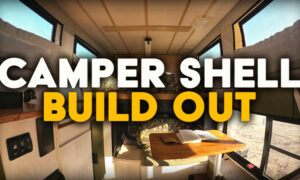This is the story of how a 2004 Freightliner M2-106 and a 2014 Arctic Fox 1150 were assembled into one of the most impressive truck and camper combinations on the planet.

When most truck campers see an unusual truck and camper combination, they might be impressed at first blush, but then they always ask, “Why did they do that?”
With truck campers specifically being designed for pickup trucks, why would anyone match a truck camper with anything else? It’s like messing with milk and cookies, eggs and toast, peas and carrots, lawns and sprinklers, or La-Z-Boys and football. No one dares to defy these noble combinations, right?
Well, you’d be surprised. One look through our Extreme Rigs section and you’ll find plenty of rig rebels, pickup insurgents, and slide-in separatists. These open thinkers discovered another way to solve their truck and camper needs, and dared to bring their wild visions into reality. Unimog and a pop-up? Peterbuilt and a hard-side? Firetruck and a triple-slide? Why not?
Jon and Laurie Schnebly were inspired to join this radical truck and camper matching revolution by the very electrons of this supposedly fine publication. With a Freightliner M106 already on hand, they set out to assemble a one-of-a-kind truck and camper rig. As you’re about to read, finding the inspiration was easy, but designing and assembling the rig to be safe, fully functional, and street legal was not.
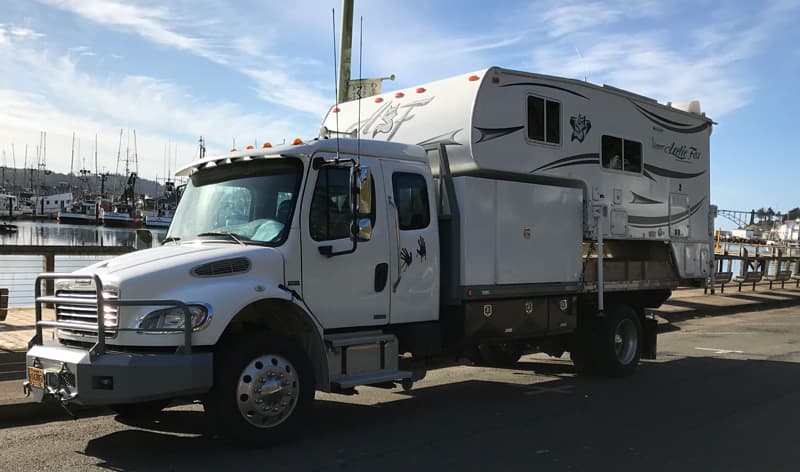
TCM: No one just decides to build a Freightliner truck camper rig. What set you on this unusual path?
Jon: My parents had a camp trailer when I was growing up. When my sister, brother and I were teenagers, my parents bought a Skyline Weekender truck camper.
We frequently traveled to California to visit relatives and the truck camper was an easier way for all of us to travel. That was also great exposure to the truck camping lifestyle.
In my twenties I bought my first truck camper; a Lance 11-foot model. Unfortunately, my career got in the way and camping took a twenty year hiatus.
When my career schedule changed, we purchased another Skyline truck camper. That was followed by a fifth wheel that we used for another four years.
That brings us to September of 2014. We stayed with friends while attending the Pendleton Round-Up. They happened to have an Arctic Fox 1150 truck camper, and we both immediately fell in love with it. Before leaving, we placed an order and picked up our own Arctic Fox 1150 in January of 2015.
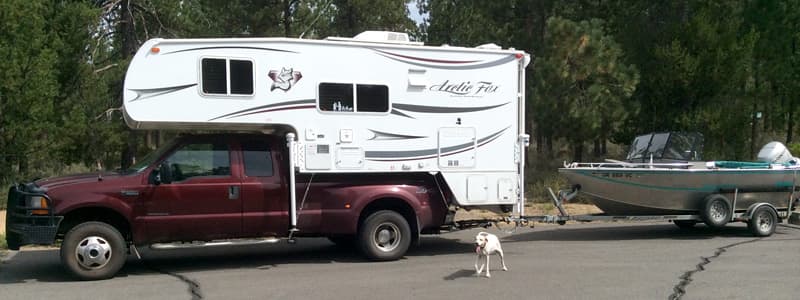
TCM: Your friends probably didn’t have their Arctic Fox mounted on a Freightliner, so where did that idea come from?
Jon: When we bought the Arctic Fox, we had a Ford F350 dually. For our particular truck, the weight of the 1150 was too much. After about 18-months, I started researching another solution.
I already owned a Freightliner M-2 with a fifth wheel toter bed. That set up was no longer necessary since we had sold our fifth wheel. That’s when I got the idea of converting the Freightliner to a 16-foot flatbed with gooseneck and receiver hitches.
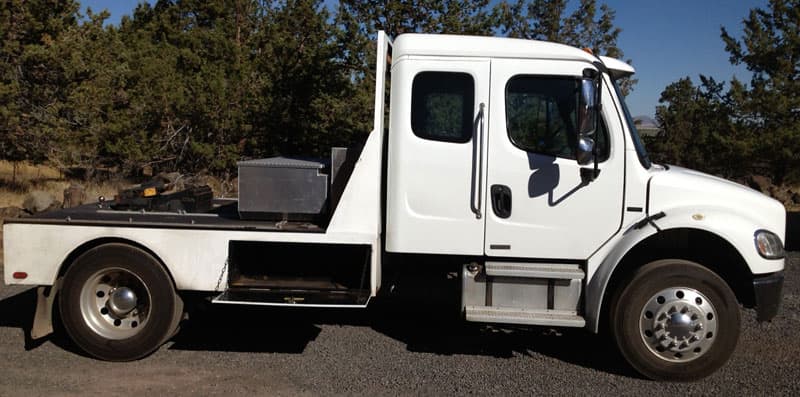
TCM: Most folks reading this interview are probably wondering why you didn’t just go purchase a heavier duty pickup truck? For example, a Ford F-550.
Jon: That was always an option, but a Ford F-550 would have cost $75,000. I already had the Freightliner, and it would cost significantly less to just modify it for the Arctic Fox. Besides, the Freightliner is the equivalent to a 750, or a five ton truck.
TCM: Let me back you up a bit. Why did you buy the Freightliner for the fifth wheel?
Jon: I found it used at a good price with only 70,000 miles, which is essentially brand new for a truck like this. I have 540 acres of land, a bulldozer and tractors, so I use the Freightliner for other things. It makes sense for us.
TCM: What is the GVWR and payload capacity of your Freightliner?
Jon: With the new 16-foot flatbed, the Freightliner itself weighs 14,000 pounds. With the camper loaded, full water, full fuel, and full storage boxes, the Freightliner and Arctic Fox 1150 weigh 23,000 pounds.
The Freightliner has a GVWR rated at 26,000 pounds. Here in Oregon you can have a normal driver’s license at 26,000 pounds, but at 26,001 pounds you need a Class A license.
The Freightliner hardly notices the camper and the Jeep or boat we tow behind it. The Freightliner, even with the extended bed, turns inside the Ford and is more comfortable to drive and ride in.
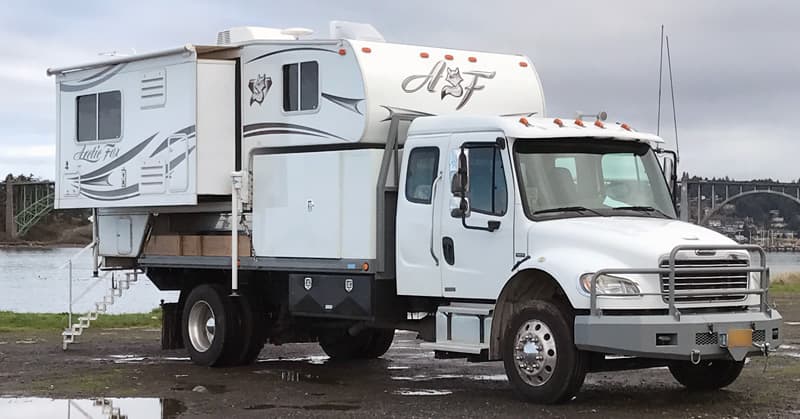
TCM: The Freightliner turns inside the Ford? That seems impossible.
Jon: The Freightliner can make a U-turn inside the Ford because its front wheels are located almost below the cab and the front tires have the same width as the outside duallies. As a result, it turns sharper than a normal wheels forward pickup truck.
The Freightliner also has incredibly comfortable air seats. As we drive down the road, we are looking over everyone and can see everything. A pickup truck does not have that kind of comfort or visibility.
I worked on a farm for eight years as a kid so I’ve driven this kind of truck while doing farm work. Driving this truck is no big deal. My wife even enjoys driving it.
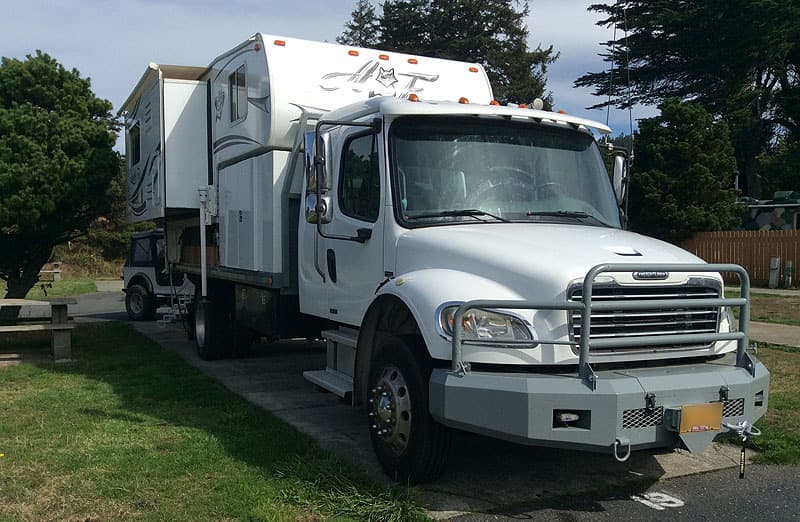
TCM: Tell us the story about how you designed and assembled your Freightliner rig.
Jon: After selling the fifth wheel, I actually tried to sell the Freightliner, but I couldn’t get the price I wanted. That’s when I looked at a Ford F-550, but the price didn’t make sense.
About that time, you published a story about a Peterbuilt truck camper and I thought, “Oh, that could work!” Then I took careful measurements of the Freightliner and Arctic Fox and thought about what it would take to put such a rig together.
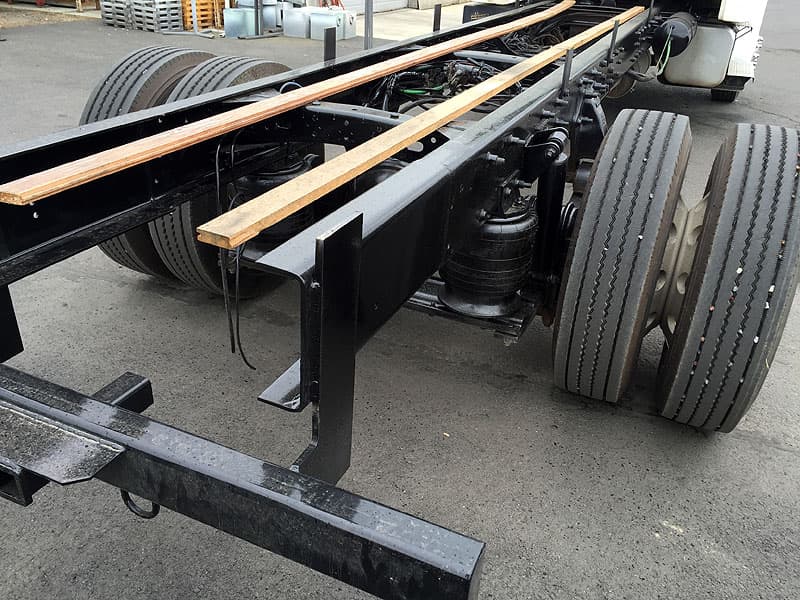
Above: Extending the wheelbase on the Freightliner was done at a specialty shop
Once I had an idea of what needed to be done, I talked to local truck shops about extending the wheelbase, and explained my plan. I brought my Ford truck and Arctic Fox rig to the companies to show them the camper. That process of interviewing shops and designing what needed to be done took about six months.
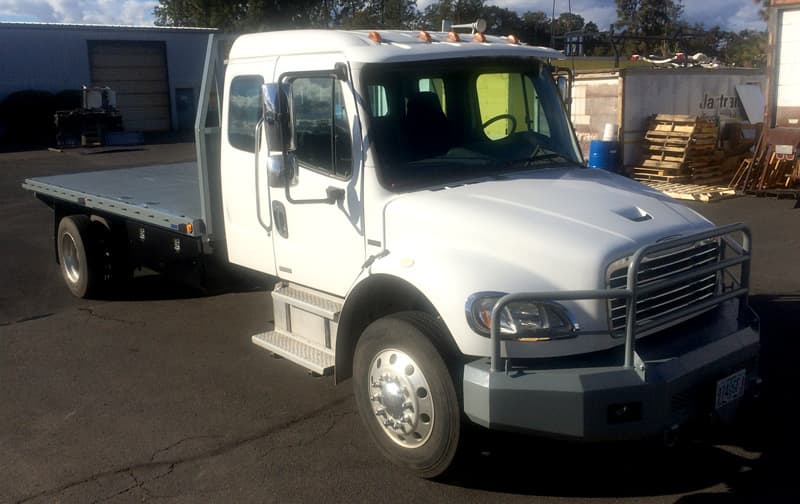
Above: Freightliner with 16-foot flatbed
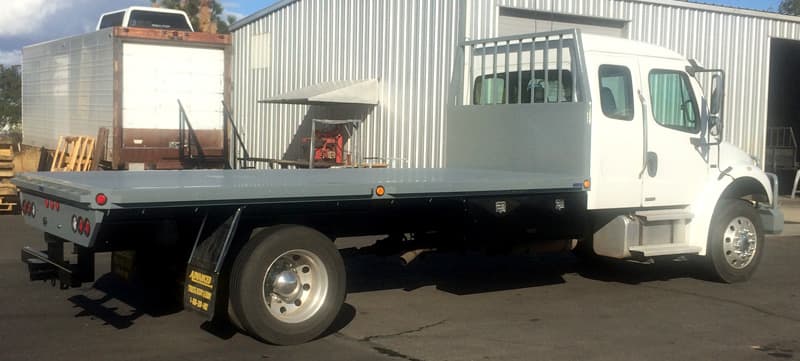
Above: Freightliner with 16-foot flatbed
I decided on 16-foot flatbed, 9-feet of that being the camper, and then 7-feet for the cabover and storage box. The cab of the Freightliner is really high, so I couldn’t do a traditional cabover camper set-up. The resulting rig would have been 15-feet high, which exceeds the legal height limit. So, 9-feet of the camper worked out to be on the flatbed.
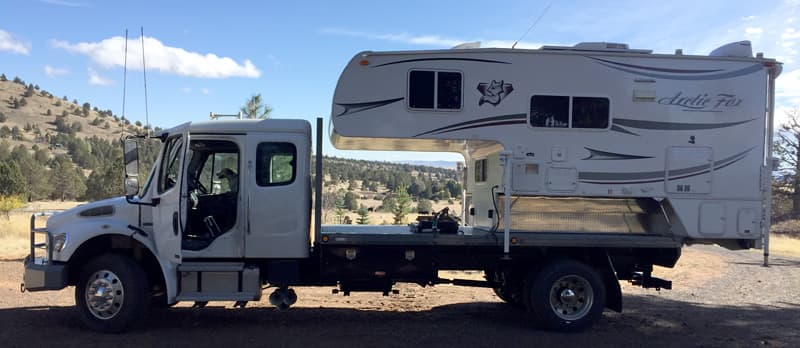
Above: Freightliner truck camper before storage box was added
That moved the camper back and necessitated extending the wheelbase of the Freightliner. The center of gravity needed to be over the rear wheels, and the extra flatbed length would allow for 7-feet of upfront storage.
The shop we chose was more than confident of the build. They extend truck wheelbases all the time. They welded a 4-foot chunk of frame on both sides with a bolted fishplate over the welds as an extension. It is a certified extension that meets DOT requirements. It was not just a welder hoping it was going to hold.
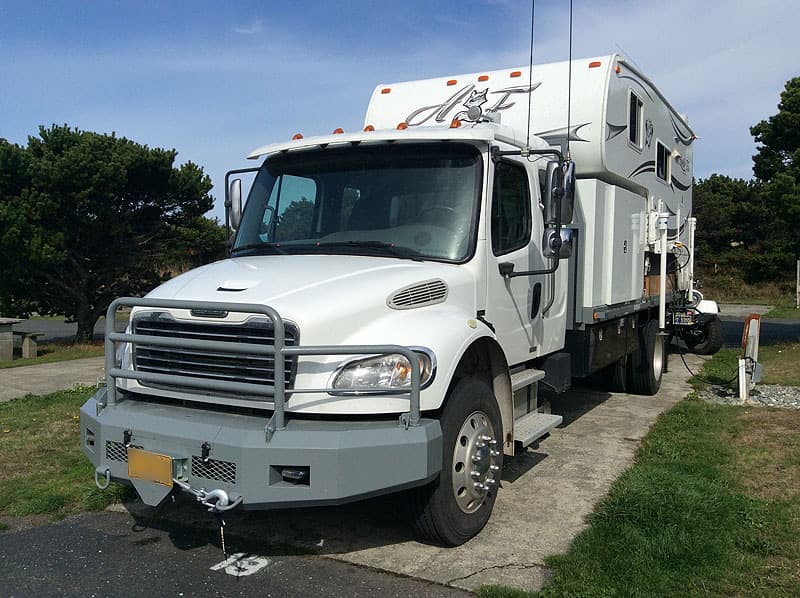
Above: This Freightliner truck camper rig’s height is 13’4″
TCM: That’s incredible. How tall is the loaded rig?
Jon: The height is 13’4”. That puts us about a foot taller than our previous F-350. It’s a safe height for most roads, but we need to watch the overpass and bridge heights.
The Freightliner is only 7-feet longer than our previous truck and camper rig.

Above: Freightliner truck camper tie-downs and turnbuckles
TCM: Tell us about your tie-down and turnbuckle set-up.
Jon: I have a 3/8-inch welded rub rail all around the flatbed which provides the anchor for the tie-downs. The rail was added when the bed was built.
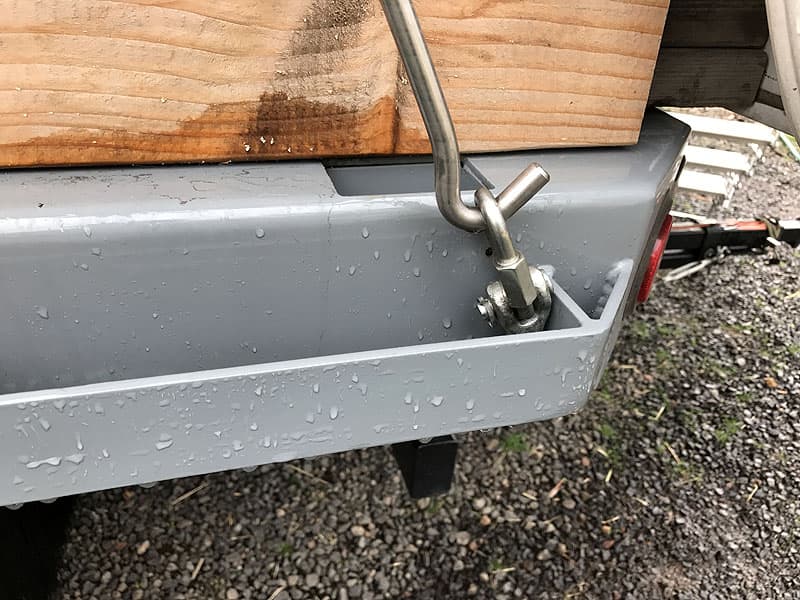
Above: Freightliner truck camper tie-downs anchored on rub rail
The rub rail is 3/8-inch steel bar stock welded to the bed. It’s very strong and allows me to slide the camper some if needed. I have never had the camper slide.
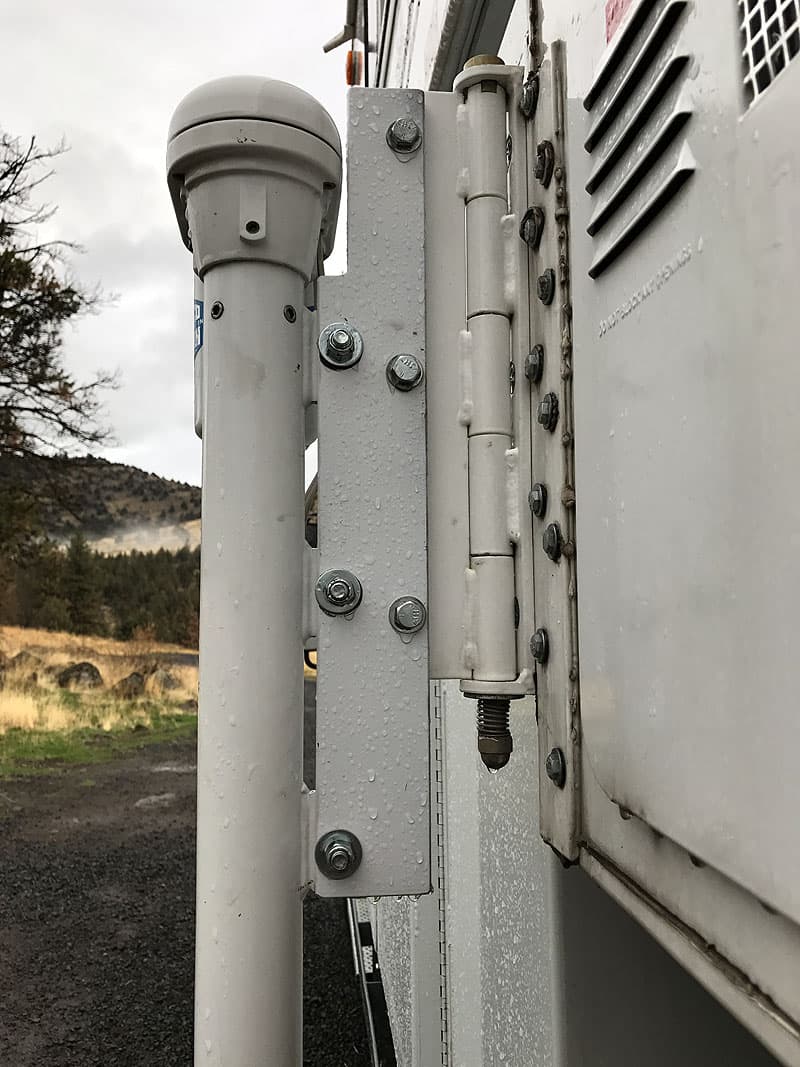
Above: An extension was built onto the jacks using 1/2-inch flat plate
TCM: How do you load and unload the camper? The stock jacks certainly don’t reach the ground with the camper being mounted that high.
Jon: The bed is too high for the camper jacks to lift the camper off. To address this, I built an extension using 1/2-inch flat plate. That lowered the jacks 5-inches; perfect for easily driving out from under it.
I load the camper myself most of the time. With the Freightliner, I can see everything. The bed is also a great alignment guide when putting the camper back on. It is faster and I can get it straighter than with the pickup. I can load or unload the camper in ten to fifteen minutes.
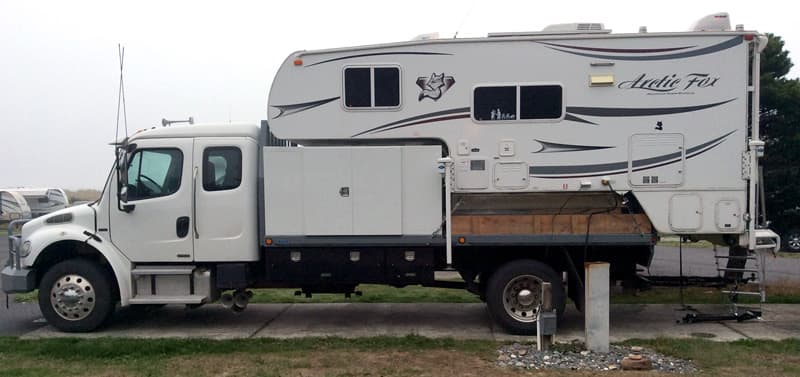
TCM: How can you see everything with the big storage box and no visibility to the camper?
Jon: I have a couple pieces of rope that hang from the sides of the camper. The rub rail on both sides of the truck bed exactly match the camper. When I back up, I know if I’m right on the mark, or not. It is truly much faster. I know the struggle of loading with a regular truck camper, and this is a piece of cake.
The truck also has suspension dump which lowers the bed about 4 to 5-inches to increase the clearance. The back of my truck doesn’t have springs. My suspension is just air bags, and I’ve got 12-inches of diameter with my air bags. In lieu of having springs, that’s what you run on.
TCM: Your Freightliner doesn’t have rear spring packs?
Jon: Higher quality trucks don’t have springs at all. They have primary and secondary air systems, so they have a back-up air system. I have a compressed air tank under the truck. The brakes and air bags all run on air, and the brake system has a back-up hydraulic system.
Since the rig is higher and the suspension in the Freightliner is stiffer, the camper experiences more sway up high. We have to run wood rods in our camper’s upper cabinets or the dishes and glasses end up on floor. I have no perception of the camper being on the truck when I’m driving.
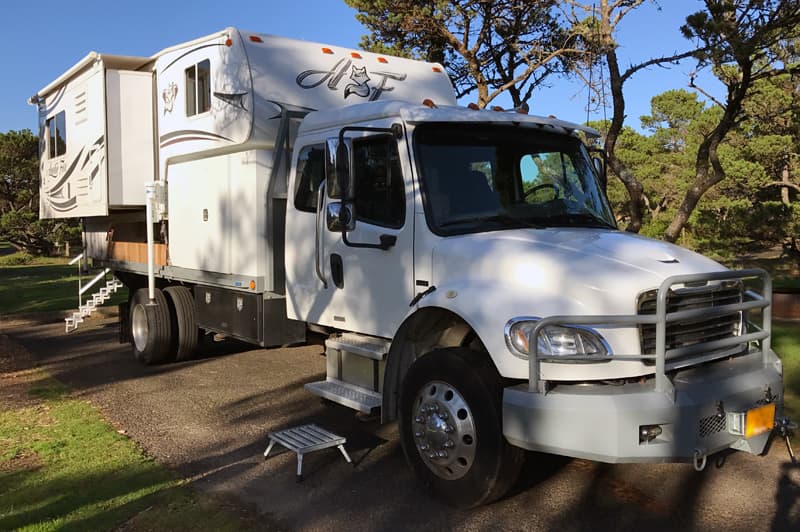
TCM: Given the increased height of the rig, are there any issues getting in and out of the camper?
Jon: With our previous Ford F-350 rig, we just had a step stool and the Fox Landing. With the height of this truck, I knew I would have to do something different.
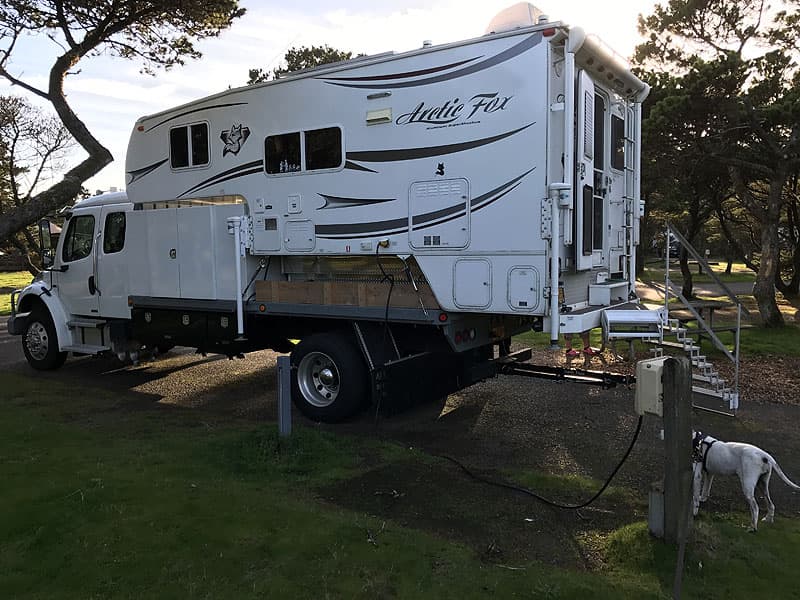
I took the step off the Fox Landing and attached Torklift Glow Steps to the platform so they would reach the ground and be able to adjust to different ground heights. Then I added the railing for comfort and stability.
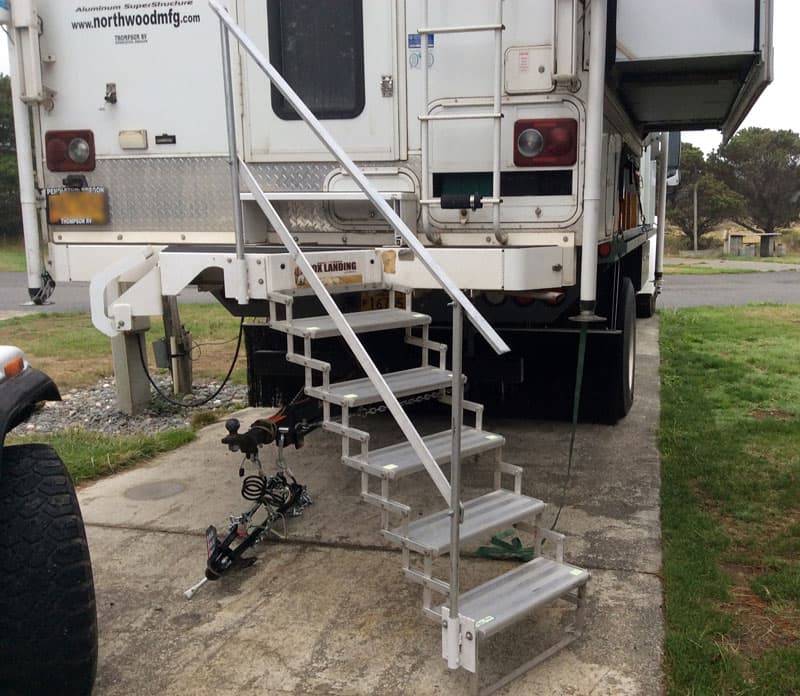
All the steps are 6-inches high, which is standard tread height. We just have more steps. With the railing and sturdiness, it’s safe. The railing never impedes us from opening the door. I designed it that way, so it works fine.
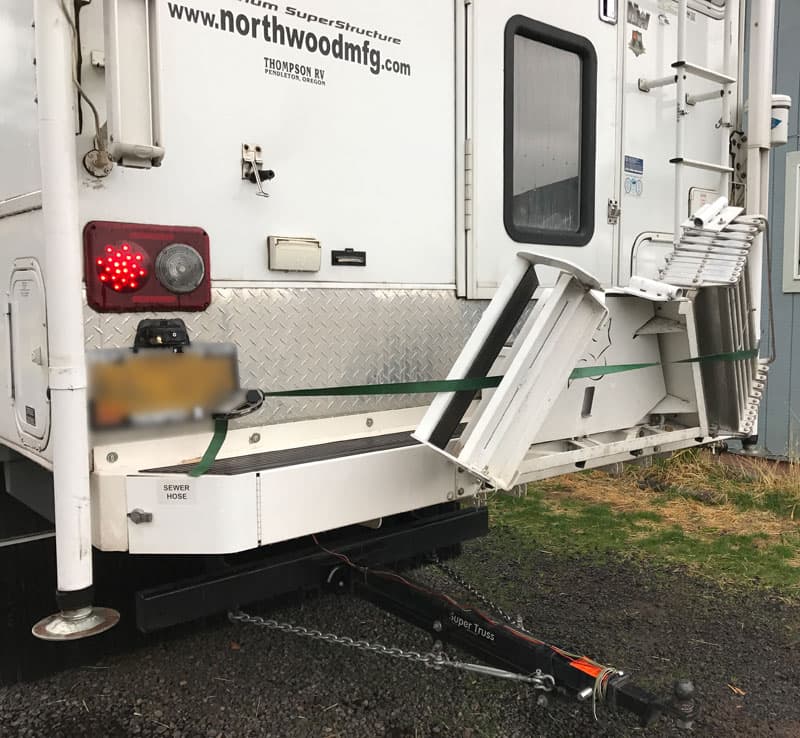
Above: Fox Landing and Glow Steps secured for travel
My 84 year old mother-in-law comes with us all the time. With the additional steps and railing, she can get into the rig comfortably. The lower piece on the railing is for the dogs. Now everyone can get into the camper.
TCM: Tell us about the exterior storage on your rig.
Jon: The front upper box is 8-feet wide and 7-feet long. It goes from the front of the camper to the headache rack. There are barn doors on both sides of the big box that measure 42-inches wide by 38-inches high.
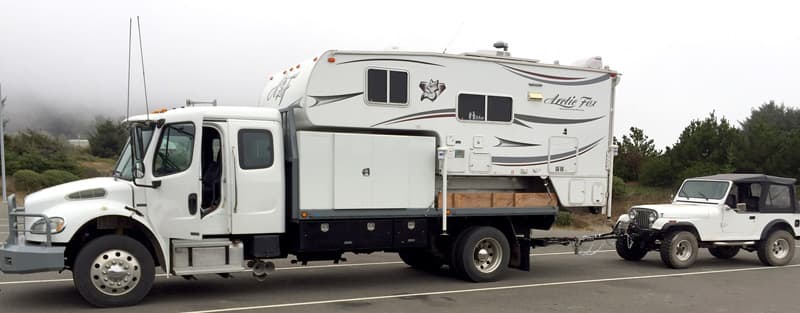
Above: They sometimes tow a Jeep when traveling
The original plan was to put an ATV up there, but we switched to towing the Jeep. The Jeep is a more versatile option. In the big box I have room for the ladder, bikes, barbecue, loading totes, and appliances we don’t use often.
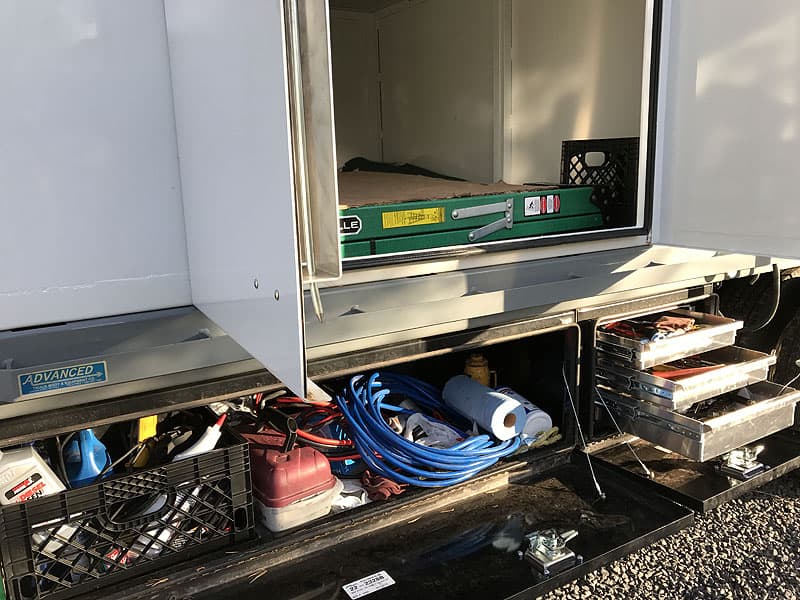
Above: The driver’s side underbed box storage area
The truck underbed boxes are 5-feet long. There is also a 24-inch wide under bed tool chest on the driver’s side. The driver’s side underbed box has the connection for the air hoses, the tire chains, stuff for the winch, and oil.
The bumper was changed to a custom winch bumper by the company that built the bed. The addition of the 17,500 pound winch gives us the comfort for winter driving if we have problems, though the truck is very stable in snow and ice. We have already used it once to pull some people in a van out of a muddy ditch on the way to the coast.
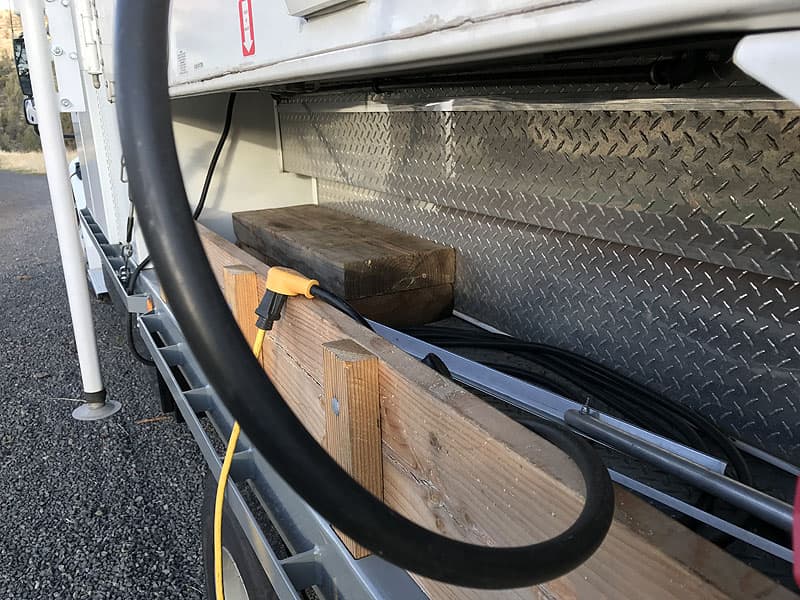
Above: Side bin storage are under the camper’s wings
The side bins under the camper and on the bed carry firewood, leveling blocks, stair railing, the hitch for the Jeep, and a step stool for my mother-in-law to use for getting into the truck’s cab. Now I have the room for everything I want to bring.
TCM: What kind of fuel mileage do you get with the Freightliner?
Jon: The engine is totally different than the 7.3L Powerstroke diesel in my old Ford. Everything is truck size and very heavy duty, so it’s easy to work on. It’s built for a million miles of service and looks that way.
My F350 averaged 10 miles per gallon with the camper loaded. The Freightliner gets the same mileage and it’s a heavier truck.
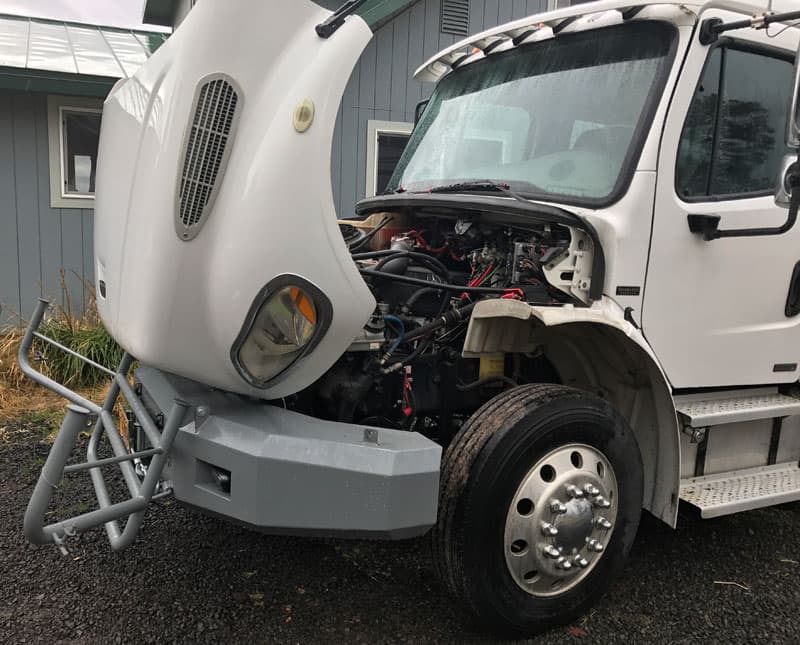
Above: The bumper brush guard folds down and the hood totally exposes the engine
TCM: What engine does the Freightliner have?
Jon: It has a 280 horsepower Mercedes (Detroit Diesel) 6.4L engine that’s very efficient. The transmission is an Alison 6-speed that runs at about 2,000 rpm at 65 miles per hour. It is geared low, but even with the camper and boat it has not gone below 45 miles per hour on a hill. It’s also much easier to drive than the F-350.
With the Freightliner, it’s also easier to check the fluids since the bumper brush guard folds down and the hood totally exposes the engine.
Since the truck has a redundant air system for brakes, I connected a line for air tools in the driver’s side bed box. It provides 120 psi; enough for an impact wrench and for filling tires.
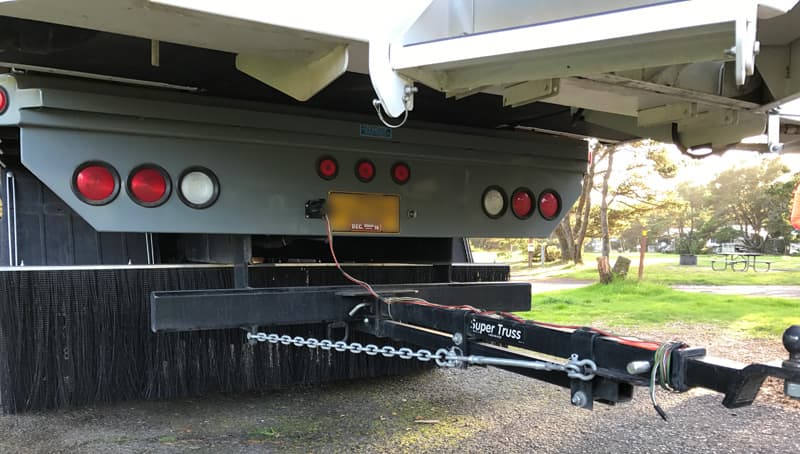
Above: Torklift SuperHitch with a 4-foot SuperTruss extension makes it possible to tow the 17-foot Hewescraft Sea Runner and a 1984 Jeep CJ-7
TCM: You already mentioned towing a Jeep. Tell us about the Jeep and anything else you tow with your truck camping rig.
Jon: We tow a 17-foot Hewescraft Sea Runner and a 1984 Jeep CJ-7. Both weigh about 3,500 pounds. For our 2000 Ford F350 dually, I purchased the Torklift SuperHitch with a 4-foot SuperTruss extension to pull with. When we changed to the Freightliner I had the same type of receiver hitch built on the bed to accept the extension. Since there was not a frame mounted version for the truck, they made a modification for the bumper to pull 12,000 pounds and handle a 2,000 pound hitch weight.
It works great and the boat and Jeep follow the truck’s tracks well. I added a backup camera to the radio/navigation receiver in the truck to observe the towed Jeep or boat.
TCM: We have talked a lot about your Freightliner and truck camper set-up. What about your truck camping lifestyle?
Jon: We do a lot of fishing, hiking, and photography. I will add hunting when I retire. I am also able to take the rig to some of my work sites as opposed to using a hotel.
TCM: What do you do for a living?
Jon: I do transition planning for hospitals that build new facilities or add to their existing facility. I help them figure out how to staff, stock and operate the facility, then coordinate loading the facility with new equipment, furniture and supplies. Then I coordinate the relocation of old equipment and furniture as well as the move of patients.
I am on site three to five days every month until the move happens. If the hospital is nearby, I can stay in the camper onsite and it’s like I’m at home.
For the hospitals in Grand Junction, Colorado, Dillon, Montana and Cody, Wyoming, I was able to take the camper during the move. My Arctic Fox has 52 gallons of fresh water and 45 gallons of grey, so showering is fine in the camper. I don’t have weight restrictions with the Freightliner. I can go fully loaded with water.
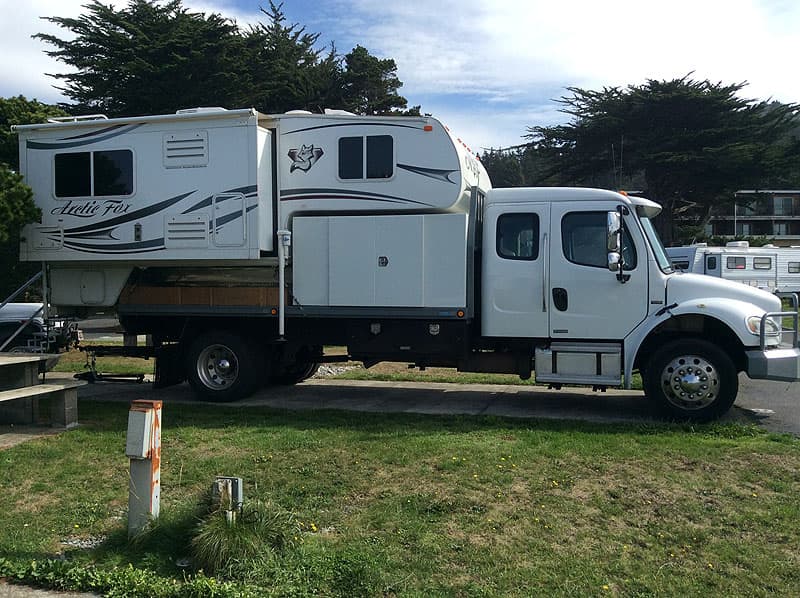
TCM: Having your rig on site for work sounds perfect. Where have you been with your truck camper that you would recommend to other truck campers?
Jon: We have been all over the Oregon Coast, the Cascades, eastern Oregon, and Washington, Idaho, and western Montana. Each place has its special qualities and we just enjoy getting to different climates, meeting friends, and exploring different areas. We also are microbrewery groupies so you will always find us stopping in odd places to try the local beers.
The Oregon coast before June and after Labor Day weekend can’t be beat if you want to enjoy the ocean. Oregon State Parks are awesome! Odell Lake, East Lake, and Crescent Lake in the Cascades are beautiful placed to hike, fish, and just enjoy.
Wallowa Lake and the surrounding country in northeastern Oregon is also hard to beat. We also like the country from Petersburg, Montana up through Missoula, Kalispell, and Libby, Montana. The vistas, animals, and backcountry are wonderful. We have also explored Lake Pend Oreille in Idaho and hope to go back to see more.
TCM: Do you dry camp with your truck camper?
Jon: We frequently dry camp, even when there is water and sewer to attach to. If there’s shore power available, we use it.
East Lake and Odell Lake are two of our favorites. We can dry camp at these sites for about five days with our holding tanks. With the 150-watt solar panel system, we never run out of 12-volt power. We are also spoiled by our water at home coming from a good well, so use it from the tank as long as we can before going to campground water.
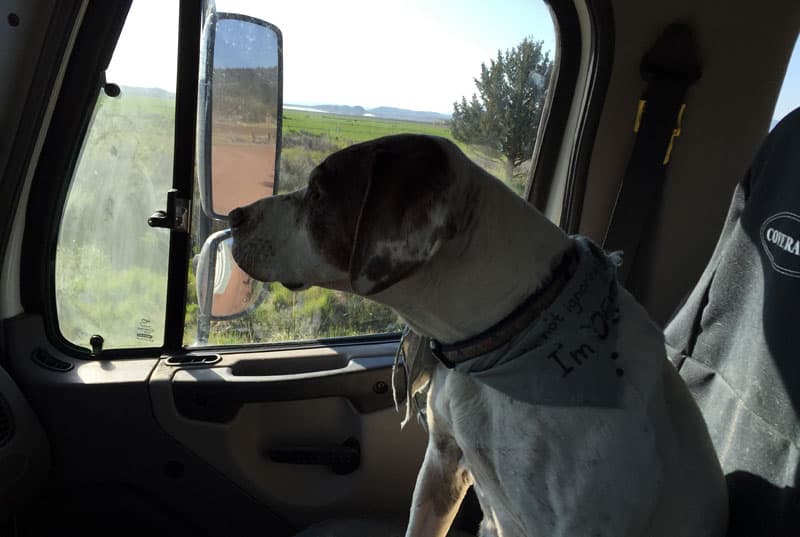
Above: Parker riding in their truck
TCM: Tell us about your dog. He looks like he enjoys truck camping with you.
Jon: We are down to one dog; an English Pointer named Parker. We have had as many as three pointers but, due to age, we are down to our 14-year old Parker. My mother-in-law has a small dog that also travels with us.
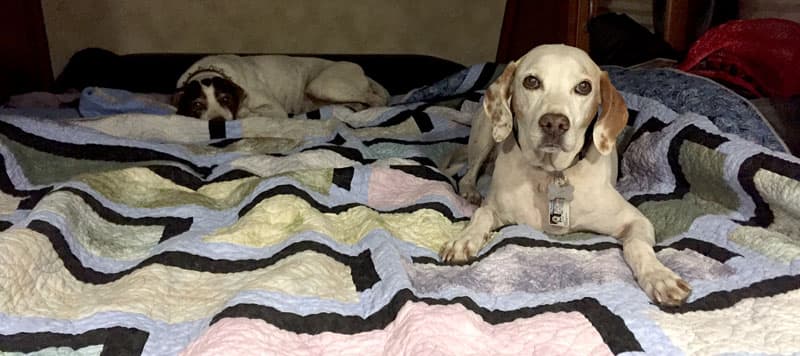
Above: Parker and Sadie in their Arctic Fox camper
TCM: What are your truck camping plans for the future?
Jon: We are looking forward to visiting Alaska and traveling the southern Canadian route to Nova Scotia. We will explore along the Canadian border in the United States when I retire in a couple of years.
We have also used our camper skills in Australia and New Zealand. We want to spend more time in Australia and pick up where we left off in Melbourne and go east to Sydney and north up the coast.
Jon and Laurie Schnebly’s Rig
Truck: 2004 Freightliner M106, Extended Cab, 4×2, Diesel, Dual Rear Wheel, 16-foot custom flatbed
Camper: 2014 Arctic Fox 1150
Tie-Downs/Turnbuckles: Torklift Fastguns
Suspension: Stock air bags
Gear: Fox Landing step, Torklift GlowSteps, Torklift SuperHitch 4-foot Extension




















